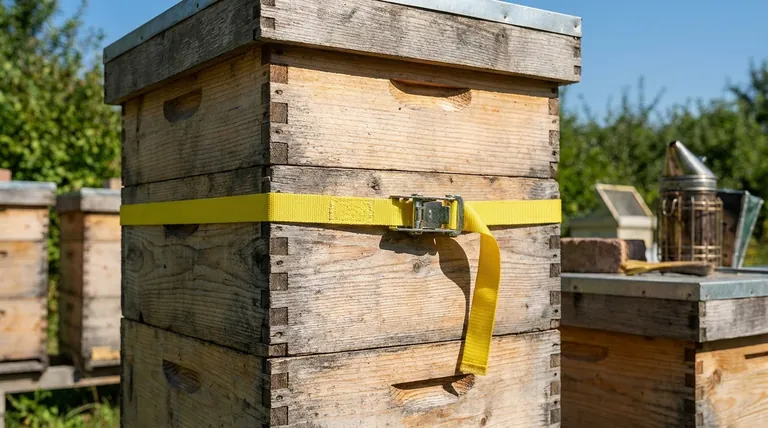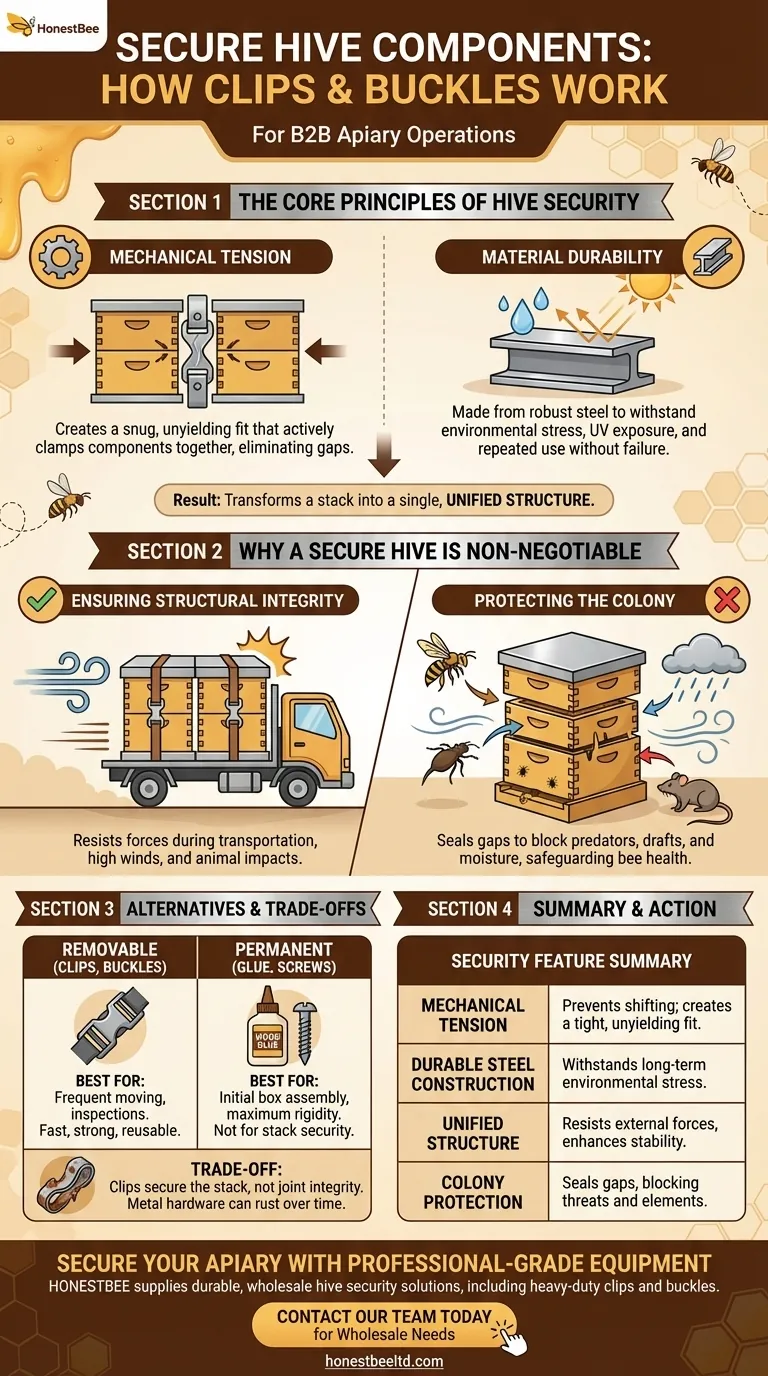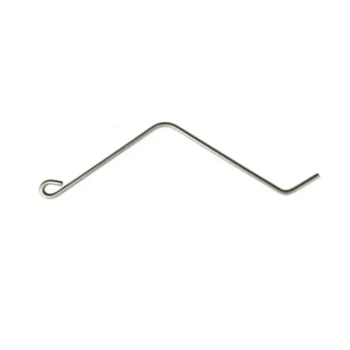At their core, hive clips and buckles provide security through two primary mechanisms: mechanical tension and material strength. Their design creates a tight, unyielding fit that physically clamps hive components together, while their durable steel construction ensures this hold withstands environmental stress and repeated use over time.
The real purpose of hive clips and buckles is to transform a stack of separate boxes into a single, unified structure. This protects the hive's integrity against external forces and safeguards the colony within from environmental threats.

The Core Principles of Hive Security
To understand why these simple devices are so effective, we need to look at both their design and their construction. Each aspect plays a critical role in maintaining a stable and protected environment for the bees.
Mechanical Tension and Fit
The fundamental job of a clip or buckle is to apply force. The design ensures a snug, tight fit around the hive components, actively pulling them together.
This constant tension eliminates gaps and prevents the individual boxes from shifting, sliding, or becoming detached from one another. It's a simple but highly effective mechanical lock.
Material Durability
Hive clips and buckles are typically made from steel, a material chosen for its strength and resilience. This is not a trivial detail.
This robust construction ensures they can withstand the rigors of outdoor exposure, from intense sun to freezing rain, without failing. Their durability provides a reliable, long-term security solution for the beekeeper.
Why a Secure Hive is Non-Negotiable
An unsecured hive is a vulnerable hive. Using clips or buckles is a critical step in risk management, directly impacting the colony's health and the beekeeper's peace of mind.
Ensuring Structural Integrity
A beehive is often moved for pollination or repositioned within an apiary. During transportation, an unsecured stack can easily topple or shift, causing chaos and stressing the colony.
Furthermore, adverse weather like high winds or even a bump from a large animal can compromise the hive's structure. Clips and buckles are the first line of defense against this physical disruption.
Protecting the Colony
Gaps between hive bodies are open doors for threats. An unsecured hive can expose the bee colony to predators like wasps and mice or to harsh environmental elements.
Even a small opening can create a draft, allowing rain to seep in or heat to escape, putting the entire colony's health at risk. A tightly secured hive is a well-defended fortress.
Understanding the Alternatives and Trade-offs
While clips and buckles are excellent for external security, they are part of a larger picture. It's important to know how they compare to other methods.
Removable vs. Permanent Fastening
Clips and buckles are designed for temporary, strong fastening. Their key benefit is that they are easily removed for hive inspections and then quickly re-secured.
For permanent structural bonds, especially during initial assembly of boxes or frames, wood glue and screws are often used. These are not for securing the stack, but for ensuring each individual component is solid before it's put into use.
The Downside of Convenience
The primary trade-off for clips is their external nature. While they secure the stack, they don't reinforce the joints of the boxes themselves. Over time, any metal hardware left outdoors can also be susceptible to rust if its protective coating is damaged.
Making the Right Choice for Your Goal
Securing your hive components is not optional. The method you choose should align with your beekeeping practices.
- If your primary focus is frequent moving or inspections: Hive clips, buckles, or ratchet straps are the ideal choice due to their strength, speed, and reusability.
- If your primary focus is maximum stability in a permanent location: Use clips or straps for stack security, and ensure your boxes are first assembled with wood glue and screws for ultimate rigidity.
Ultimately, using the right fastening method transforms your hive from a fragile stack into a secure home for your bees.
Summary Table:
| Security Feature | How It Protects Your Hive |
|---|---|
| Mechanical Tension | Creates a tight, unyielding fit that clamps boxes together, preventing shifting. |
| Durable Steel Construction | Withstands environmental stress and repeated use for long-term reliability. |
| Unified Structure | Transforms separate boxes into a single, stable unit to resist external forces. |
| Colony Protection | Seals gaps to block predators, drafts, and moisture, safeguarding bee health. |
Secure Your Apiary with Professional-Grade Equipment
Protecting your investment and ensuring the stability of your hives is paramount. HONESTBEE supplies commercial apiaries and beekeeping equipment distributors with durable, wholesale-focused hive security solutions, including heavy-duty clips and buckles designed for long-term performance.
Contact our team today to discuss your wholesale needs and discover how our equipment can enhance the safety and efficiency of your beekeeping operations.
Visual Guide

Related Products
- Professional Galvanized Hive Strap with Secure Locking Buckle for Beekeeping
- Heavy Duty Ratchet Hive Strap
- Heavy-Duty Galvanized Steel W-Style Pallet Clip
- Versatile U-Style Steel Pallet Clip
- HONESTBEE Advanced Ergonomic Stainless Steel Hive Tool for Beekeeping
People Also Ask
- What is the best length for straps used around beehives? Why 12 Feet is the Industry Standard
- How should a cam buckle strap be installed for optimal performance? Master the Leverage for Maximum Tension
- How can beekeepers secure the top cover of a hive? Protect Your Colony from Wind and Weather
- Can straps with hook ends be used for beehives? A Guide to Secure Hive Management
- What are the two styles of hive straps? Choose the Right Strap for Your Hive Security



















